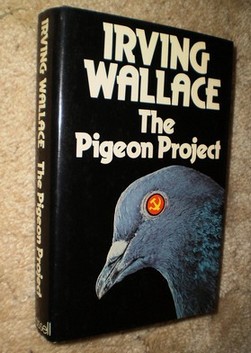ARMENIANS IN AMERICAN POPULAR FICTION
 Written at the height of the Cold War, “The Pigeon Project” (1979), tells the fictional story of the British-American scientist Davis MacDonald who has discovered the key biological factor determining human longevity. The novel opens with MacDonald celebrating his discovery in his laboratory in Suchumi, Soviet Abkhazia, where he has been studying the underlying reasons for the unusual longevity of the locals. (Interestingly, and perhaps prophetically, never once in his book does the author mention Georgia). In the best traditions of Cold War era political thrillers, the local KGB agent gets a whiff of the discovery and reports to his superiors who immediately appear on the scene trying to keep it for the Soviet Union. MacDonald, however, manages to escape by taking a plane to Venice, planning to present his newly found elixir of life at a press conference. It soon transpires, however, that Communists have won local elections in Venice and are working closely with the KGB to prevent Professor MacDonald from giving up his discovery to the world. MacDonald is kidnapped in Venice and taken to the island of San Lazzaro, owned by the Armenian Mechitarist order. MacDonald is kept in the custody of Armenian monks who treat him well but, under the circumstances, have to guard him closely in his monastery cell. Wallace devotes several pages to the detailed history of Mechitarist order and its origins, even discussing the consequences of Austrian domination on the Order. In one episode, the Armenian monk shows MacDonald the English-Armenian dictionary written by Lord Byron and takes him to an old tree planted by the famed English poet. Further along in the novel, an Armenian glass merchant residing in the city of Venice appears on the scene. His nephew, a Mechitarist monk named Pashal, lives on San Lazzaro and is aware of the movements surrounding the captive scientist. Through his nephew, the Armenian merchant of Venice then helps arrange a daring escape of the Professor from the island… The novel is written in the genre of political thriller, in the vein of Raymond Chandler, Graham Greene and Frederick Forsyth. At the same time, it is no idle reading material, being laden with pages of historical references, colorful descriptions of the daily lives of Venetians and city’s architectural monuments. Thus, one of the main heroes is an architectural engineer who is in charge of a project aiming to prevent the further sinking of the city into the sea. The book may be the first instance of Armenian Mechitarist monks appearing in modern fictional literature.
Written at the height of the Cold War, “The Pigeon Project” (1979), tells the fictional story of the British-American scientist Davis MacDonald who has discovered the key biological factor determining human longevity. The novel opens with MacDonald celebrating his discovery in his laboratory in Suchumi, Soviet Abkhazia, where he has been studying the underlying reasons for the unusual longevity of the locals. (Interestingly, and perhaps prophetically, never once in his book does the author mention Georgia). In the best traditions of Cold War era political thrillers, the local KGB agent gets a whiff of the discovery and reports to his superiors who immediately appear on the scene trying to keep it for the Soviet Union. MacDonald, however, manages to escape by taking a plane to Venice, planning to present his newly found elixir of life at a press conference. It soon transpires, however, that Communists have won local elections in Venice and are working closely with the KGB to prevent Professor MacDonald from giving up his discovery to the world. MacDonald is kidnapped in Venice and taken to the island of San Lazzaro, owned by the Armenian Mechitarist order. MacDonald is kept in the custody of Armenian monks who treat him well but, under the circumstances, have to guard him closely in his monastery cell. Wallace devotes several pages to the detailed history of Mechitarist order and its origins, even discussing the consequences of Austrian domination on the Order. In one episode, the Armenian monk shows MacDonald the English-Armenian dictionary written by Lord Byron and takes him to an old tree planted by the famed English poet. Further along in the novel, an Armenian glass merchant residing in the city of Venice appears on the scene. His nephew, a Mechitarist monk named Pashal, lives on San Lazzaro and is aware of the movements surrounding the captive scientist. Through his nephew, the Armenian merchant of Venice then helps arrange a daring escape of the Professor from the island… The novel is written in the genre of political thriller, in the vein of Raymond Chandler, Graham Greene and Frederick Forsyth. At the same time, it is no idle reading material, being laden with pages of historical references, colorful descriptions of the daily lives of Venetians and city’s architectural monuments. Thus, one of the main heroes is an architectural engineer who is in charge of a project aiming to prevent the further sinking of the city into the sea. The book may be the first instance of Armenian Mechitarist monks appearing in modern fictional literature.
Irving Wallace (1916-1990) was born in Chicago. Both of his parents were born in Russia and emigrated to the United States in their teens. Authored numerous bestselling novels and screenplays. Books include The Seven Minutes (1971) (novel) The Prize (1963) (novel) The West Point Story (1950).
Ashot Kozak-HarutyunyanReturn
